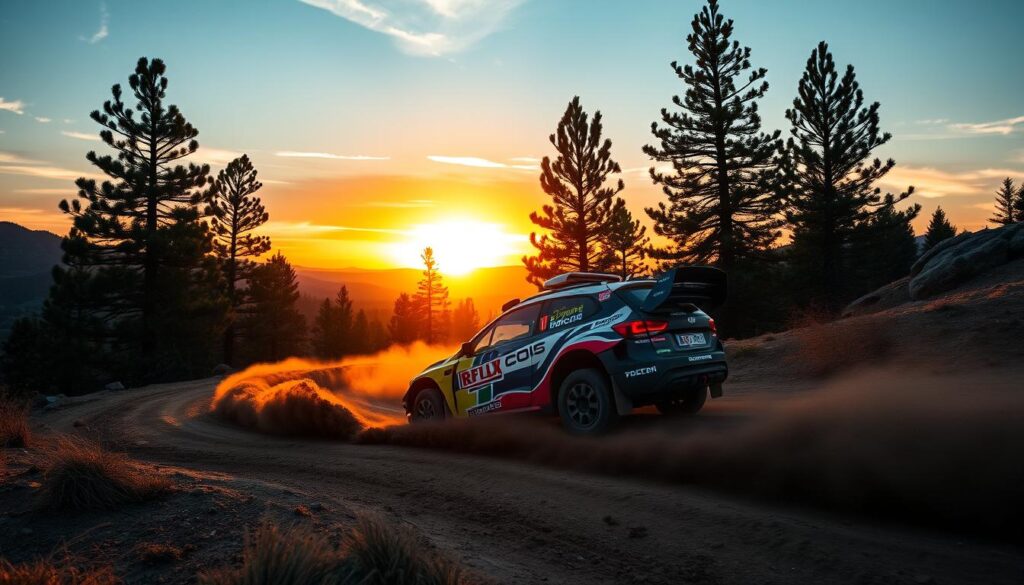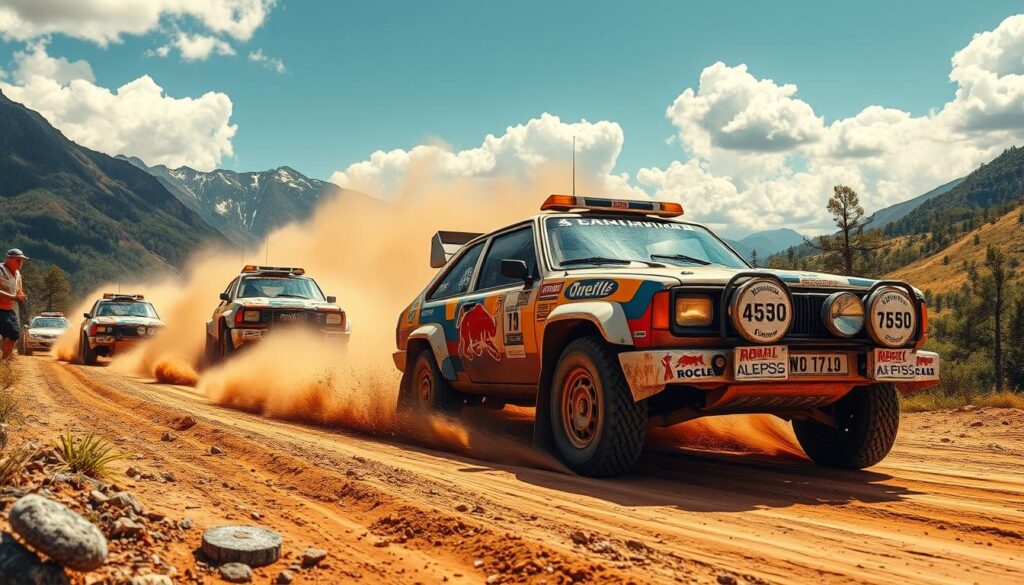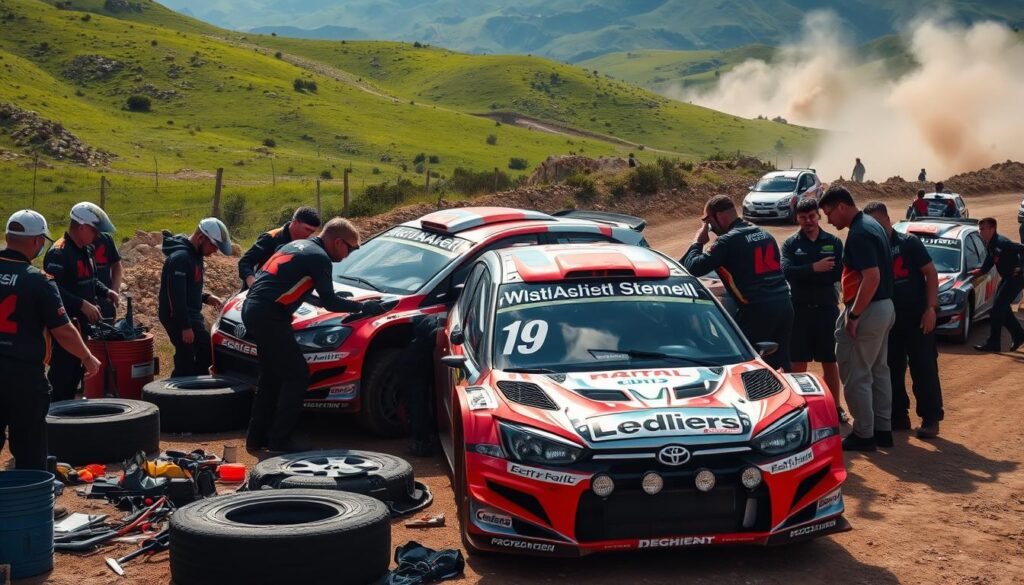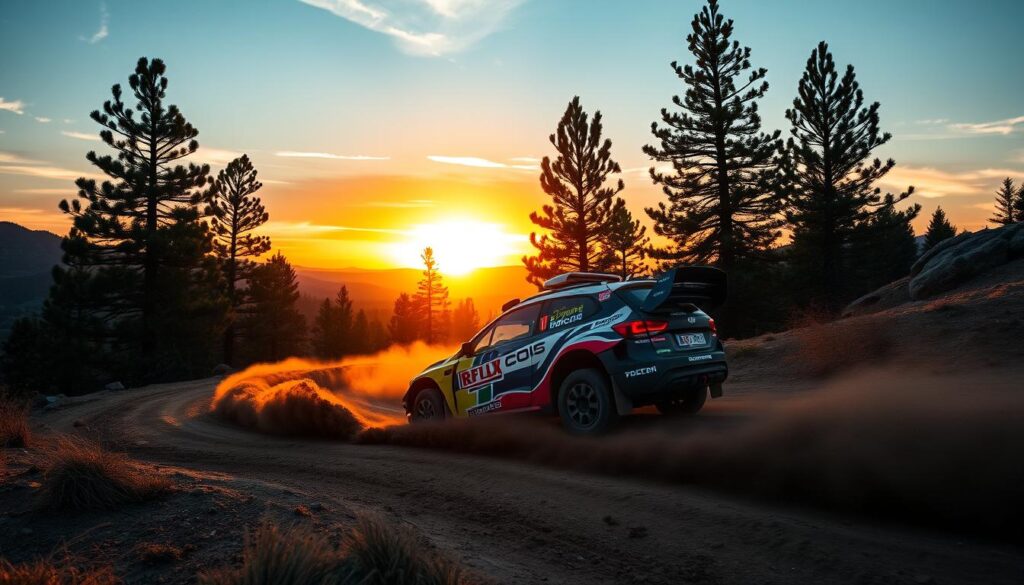The roar of engines, the smell of burning rubber, and the thrill of navigating treacherous terrain – welcome to the exhilarating world of rally racing. As a passionate motorsports enthusiast, I’ve always been captivated by the sheer adrenaline and skill required to conquer these off-road challenges. From the snow-capped peaks of the Scandinavian forests to the sun-baked deserts of North Africa, rally racing has captured the hearts of enthusiasts worldwide.
In this comprehensive guide, we’ll delve into the captivating realm of rally racing. We’ll explore its rich history, the specialized cars and equipment, and the legendary drivers who have shaped the sport. We’ll also look at the global competitions that have become the stuff of legends. Whether you’re a seasoned rally fan or someone seeking to embark on a new motorsports adventure, this article will serve as your roadmap to the high-speed, off-road odyssey that is rally racing.

In This Guide
What Is Rally Racing: Understanding the Basics of Off-Road Competition
Rally racing is a thrilling motorsport that takes drivers on outdoor adventures. It’s different from circuit racing because it uses closed roads, dirt tracks, and off-road areas. This makes it exciting for both drivers and fans.
Types of Rally Racing Categories
Rally racing has many categories, each with its own rules and challenges. Some top events include:
- Stage rallies: These have timed “special stages” and public road sections called “transit stages.”
- Cross-country rallies: Known as rally raids, they cover long distances in places like deserts and forests.
- Hill climbs: Drivers race up a road as fast as they can, testing their skills and cars.
Key Differences Between Rally Racing and Traditional Racing
Rally racing and traditional racing are both fast-paced, but they differ in key ways. Rally racing uses closed roads and faces unpredictable terrain and weather. Rally cars also have a co-driver who helps the driver with route information and pace notes.
Essential Rally Racing Components
Several key elements make rally racing events run smoothly and safely. These include:
- Time controls: Drivers must arrive at checkpoints within a certain time to avoid penalties.
- Special stages: The timed sections where drivers aim for the fastest times.
- Service parks: Areas for teams to do maintenance and repairs between stages.
Understanding these basics helps fans appreciate the unique challenges and thrills of rally racing.
The Evolution of Rally Racing Through the Decades
Rally racing has a rich history that goes back over a century. It started with early endurance races in the 20th century. Today, it’s a fast-paced, off-road competition that fans love.
The World Rally Championship (WRC) began in 1973. It brought together top drivers, teams, and cars. The WRC has kept fans excited with its fast-paced events and famous rallies.
The 1980s saw a big change with the Group B category. These cars were very advanced and powerful. They made races exciting but also challenging. The Group B era was short but had a big impact on rally racing.
Technology has also changed rally racing a lot. New rally cars and safety features have improved the sport. These changes have made the sport more exciting for drivers and fans alike.
| Decade | Significant Developments |
|---|---|
| 1920s-1960s | Early endurance races and rallies Emergence of national rally championships |
| 1970s | Establishment of the World Rally Championship (WRC) Increasing popularity and global reach of rally racing |
| 1980s | Introduction of the Group B category Technological advancements in rally car design |
| 1990s-Present | Continued evolution of rally car technology Expansion of regional and national rally championships Increased safety protocols and regulations |
The rally racing history and rally racing championships have won fans worldwide. Rally racing is an exciting and dynamic sport. As it keeps evolving, fans can look forward to even more thrilling experiences.
“Rally racing is not just a sport; it’s a way of life. The thrill of navigating treacherous roads at breakneck speeds is unmatched.”
Essential Rally Car Specifications and Modifications
Rally racing is all about speed and skill. The details of a rally car’s design and modifications are key. From the engine’s power to the safety gear, every part is made to handle tough off-road terrain.
Engine and Performance Requirements
The engine is the heart of a rally car. It needs to be powerful and quick. To get more power from smaller engines, turbochargers or superchargers are used. This helps the car go faster and reach higher speeds.
Rally cars also get special cooling systems, fuel delivery, and engine management. These changes help the car perform well, even when it’s pushed to its limits.
Safety Equipment and Roll Cage Design
Rally racing is dangerous, so safety is top priority. Rally cars have strong roll cages to protect the crew in crashes or rollovers. These cages are made to absorb impact forces, keeping the crew safe.
They also have special safety harnesses, fire extinguishers, and more. These features help reduce the risks of fast off-road driving.
Suspension and Tire Configurations
Rally racing’s rough terrain needs a special suspension system. Rally cars have adjustable dampers, strong springs, and control arms. These parts let the driver adjust the car’s handling for different conditions.
The tires are also key. They need to be tough and versatile. This way, the car can grip various surfaces, from gravel to snow.
| Rally Car Component | Specification | Purpose |
|---|---|---|
| Engine | Turbocharged or supercharged | Increased power and responsiveness |
| Roll Cage | Reinforced structure | Protect the crew in the event of a collision or rollover |
| Suspension | Adjustable dampers and springs | Adapt to various terrains and driving conditions |
| Tires | Versatile and durable | Provide traction on a wide range of surfaces |
Legendary Rally Drivers Who Shaped the Sport
Rally racing has been captivated by the talents of iconic drivers. These legends have dominated the sport and made it popular worldwide.
Sébastien Loeb, from France, is a celebrated name in rally racing. He has won nine World Rally Championship titles. His skill and consistency have made him one of the greatest rally drivers of all time.
Tommi Mäkinen, from Finland, is known for his fierce competitiveness. He won four WRC championships and had thrilling battles on challenging stages. His legacy in rally racing history is unforgettable.
The late Colin McRae, from Scotland, was a true icon. His daring and talent captivated fans worldwide. His 1995 WRC title and many wins have made him a beloved and influential rally driver.
“Rally driving is all about pushing the limits, both of the car and yourself. These legendary drivers have raised the bar, inspiring generations of fans and aspiring rally drivers to come.”
The legacies of Loeb, Mäkinen, McRae, and others continue to inspire. They showcase the sport’s rich history and lasting appeal.

Major International Rally Racing Championships
Rally racing has many top international championships that thrill fans everywhere. The World Rally Championship (WRC) is at the top, along with other series. These events are the best in off-road racing, showing off the skills of top drivers.
World Rally Championship (WRC) Events
The World Rally Championship is like the “Formula One of rally racing.” It’s the biggest rally racing series. Drivers face tough stages on different surfaces around the world. This is the ultimate test of rally driving.
Regional Rally Series and Competitions
- The European Rally Championship (ERC) is for the best drivers in Europe. Events are held in places like Poland, Belgium, and Greece.
- The American Rally Association (ARA) National Championship is the top rally series in North America. It has exciting races in the U.S. and Canada.
- The Asia-Pacific Rally Championship (APRC) covers the varied terrains of Asia and the Pacific. It includes stages in China, Japan, and Malaysia.
Notable Rally Racing Venues
Iconic venues around the world host rally racing events. Each place has its own challenges and history. Some famous venues include:
| Venue | Location | Notable Characteristics |
|---|---|---|
| Monte Carlo Rally | Monaco | One of the oldest and most prestigious rally events, known for its winding mountain roads and unpredictable weather conditions. |
| Rally Finland (1000 Lakes Rally) | Finland | Renowned for its high-speed gravel stages and challenging jumps, this event is considered one of the most demanding in the WRC calendar. |
| Rally Sweden | Sweden | The only pure winter rally on the WRC schedule, featuring stages on snow and ice, testing the drivers’ ability to adapt to the icy conditions. |
These famous venues, along with many others, draw in fans and test top drivers. Rally racing is an exciting sport for motorsports fans.
Rally Racing Team Structure and Operations
Rally racing is a thrilling sport that needs a well-coordinated team. The team includes managers, engineers, mechanics, and support crew. Each member is key to the success of the rally car and its drivers.
The team manager is at the center, overseeing everything. They handle logistics, budget, and make crucial decisions. Engineers focus on designing and improving the rally car for each event.
The mechanics are the heart of the team. They prepare the car for each event, making sure it’s ready for the challenges of off-road racing. Their quick problem-solving skills can make all the difference.
The team also relies on a large support network. This includes transportation specialists, medical staff, and safety crews. They help the team move and ensure safety during races.
| Team Role | Responsibilities |
|---|---|
| Team Manager | Oversees the entire rally racing operation, including logistics, budget, and strategic decision-making. |
| Engineer | Designs, maintains, and optimizes the rally car to meet the unique demands of each event. |
| Mechanic | Prepares and maintains the rally car, ensuring it is in peak condition for each race. |
| Transportation Specialist | Handles the logistics of moving the team and their equipment to various rally locations around the world. |
| Medical and Safety Crew | Provides emergency medical support and ensures the safety of the team during competition. |
Success in rally racing depends on a team’s coordination and dedication. From the strategic leaders to the behind-the-scenes heroes, everyone plays a vital role. Together, they strive for rally racing glory.

Navigation and Pace Notes in Rally Racing
In the exciting world of rally racing, navigation is key to winning. The co-driver, or navigator, is a vital partner. They work closely with the rally drivers to navigate the stages successfully.
Co-Driver Responsibilities
The co-driver has many important tasks. They focus on reading pace notes, which give details about the terrain and corners ahead. These notes help the driver prepare for the stage’s challenges.
Reading and Creating Pace Notes
Creating and reading pace notes is a special skill. Co-drivers write down the stage’s features, like corners and obstacles. They share these notes with the driver, helping them drive with precision.
Stage Recognition Techniques
- Comprehensive reconnaissance: Co-drivers do detailed runs to learn the stage layout.
- Visual cues: They look for landmarks and terrain features to predict turns and obstacles.
- Memory and mental mapping: Experienced co-drivers remember and map the stages, making quick decisions.
The teamwork between rally drivers and co-drivers is crucial. Their focus and navigation skills are essential for success. Together, they face the rally stages’ challenges.
Safety Protocols and Emergency Procedures
In the world of rally racing, your safety is the most important thing. There are strict safety rules to keep you and others safe. These include wearing special gear and having marshals watch over the race.
You must wear a certified helmet, fireproof clothes, and a roll cage for safety. Marshals watch the race and help fast in emergencies. They can give medical help and call for more help if needed.
If there’s an accident, the rally’s emergency plan starts right away. Medical teams and rescue vehicles are ready to help quickly. They make sure anyone hurt gets the right care and the race can go on safely.
FAQ
What is rally racing?
Rally racing is a thrilling motorsport that uses public or private roads. It involves driving production-based cars on different terrains and in various weather. This makes it a unique and challenging off-road competition.
What are the different types of rally racing categories?
Rally racing has several categories, including stage rallies, cross-country rallies, and hill climbs. Each category has its own rules and challenges. This variety offers a wide range of rally racing experiences.
How is rally racing different from traditional circuit racing?
Rally racing differs from traditional circuit racing in several ways. It uses public roads and includes co-drivers. It also has time controls and special stages. Rally racing requires different skills and strategies than closed-circuit racing.
What are the essential components of rally racing?
Rally racing includes time controls, special stages, and service parks. These elements are key for a successful rally event. They ensure fair competition and proper vehicle maintenance.
How has rally racing evolved over the decades?
Rally racing has a long history, starting with early 20th-century endurance races. The World Rally Championship began in 1973. The sport has grown, with technological advancements, including the iconic Group B era of the 1980s.
What are the key engine and performance requirements for rally cars?
Rally cars need special engine tuning and performance modifications. Adjustments to the engine, suspension, and tires are made for off-road competition. These changes ensure optimal performance and safety on various terrains and weather.
What safety equipment and roll cage design is crucial for rally cars?
Rally cars have extensive safety features, like roll cages and fire extinguishers. They also have specialized safety gear for drivers and co-drivers. These components protect the crew and meet high safety standards.
Who are some of the legendary rally drivers that have shaped the sport?
Drivers like Sébastien Loeb, Tommi Mäkinen, and Colin McRae have shaped rally racing. They have won championships and made the sport popular with their skills and personalities.
What are the major international rally racing championships?
The World Rally Championship (WRC) is the top international rally racing championship. It features events in many countries. There are also regional series and notable rallies like the Monte Carlo Rally and the 1000 Lakes Rally in Finland.
How is a rally racing team structured and operated?
A rally racing team has many roles, including team managers, engineers, and mechanics. They work together to transport equipment and maintain rally cars. This ensures the team’s success worldwide.
What is the role of navigation and pace notes in rally racing?
Navigation and pace notes are vital in rally racing. Co-drivers create and read pace notes for the driver. They help recognize stage characteristics for competitive times and safety.
What are the safety protocols and emergency procedures in rally racing?
Rally racing emphasizes safety with many measures. This includes safety equipment, course marshals, and emergency procedures. Quick response and coordination are key for safety during events.


Pingback: How to Be a Rally Driver: 9 Powerful Tips for Success
Pingback: How to Become a Racing Car Driver - Pro Tips & Guide
Pingback: Finding your motorsport passion
Pingback: MotoGP Classes Everything You Need to Know
Pingback: Top Types of Car Racing: Ultimate Guide to Speed
Pingback: Rally Cross: Your Guide to Off-Road Racing Action